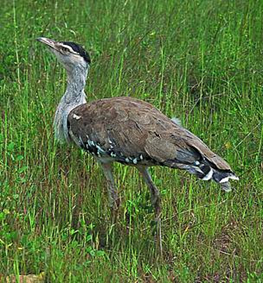TAG: GS 3: ECOLOGY AND ENVIRONMENT
THE CONTEXT: The recent waterhole survey conducted in Jaisalmer, Rajasthan, has revealed encouraging news about the population of the critically endangered Great Indian Bustard (GIB), also known as ‘Godawan.’
EXPLANATION:
- This species, which is the state bird of Rajasthan, has been teetering on the edge of extinction.
- For the first time, a significant number of these birds were observed during the annual census, marking a positive trend in conservation efforts.
Waterhole Survey Findings
- The waterhole survey, which took place from May 23 to May 24, coinciding with Vaishakh Purnima (a full moon night), recorded the presence of 64 Great Indian Bustards in Jaisalmer district.
- This annual wildlife census method leverages the extreme summer heat and the brightness of the full moon to count wildlife as they come to drink water at designated water points.
- Distribution of Sightings
- Ramdevra Region: 21 Great Indian Bustards were spotted.
- Other Regions (Sudasari, Gazai Mata, Jamra, Chouhani, Sipla, and Barna): 43 Great Indian Bustards were observed.
- Additional Wildlife Observations
- Alongside the Great Indian Bustard, the survey also recorded sightings of other wildlife species:
- Over 1000 Chinkaras (Indian Gazelle)
- 30 Desert Cats
- 150 Foxes
- Over 100 Vultures
- Alongside the Great Indian Bustard, the survey also recorded sightings of other wildlife species:
Methodology and Efforts
- To facilitate accurate counting, the forest department established 42 water points in the Desert National Park (DNP) area.
- A total of 84 forest officials were stationed on watchtowers at these points, enduring the scorching heat for a full 24 hours to ensure a comprehensive count.
- The survey is strategically conducted during Vaishakh Purnima due to:
- Extreme Heat: Temperatures often exceed 45 degrees Celsius, compelling wildlife to visit waterholes at least once in 24 hours.
- Bright Moonlight: The full moon provides natural illumination, making it easier to spot animals from a distance without artificial lighting.
- In 2022, the waterhole survey recorded 42 Great Indian Bustards, but the count was not conducted in 2023 due to unusual rains from a western disturbance.
- The 2022 survey also included around 34 different types of wildlife species, totaling about 8,000 animals.
Conservation Efforts
- The Indian government, alongside the Ministry of Environment, Forest, and Climate Change (MoEFCC), the Rajasthan Forest Department (RFD), and the Wildlife Institute of India (WII), has been actively working to conserve the Great Indian Bustard.
- Significant efforts include:
- Breeding Centres: Established in Sam, Sudasari, and Ramdevra in Jaisalmer, these centres have played a crucial role in the increase of the GIB population.
- Protection Measures: The GIB is protected under the Indian Wildlife (Protection) Act, 1972, and is listed in Schedule I of the Convention on Migratory Species (CMS) and Appendix I of the Convention on International Trade in Endangered Species of Wild Fauna and Flora (CITES).
- Currently, there are approximately 182 Great Indian Bustards, including 34 at the breeding centres.
- This increase is a significant achievement, considering the critically endangered status of the species, with fewer than 200 individuals remaining in the Indian subcontinent.
Great Indian Bustards:
- It is known as the Indian Bustard, is a majestically large bird found on the Indian subcontinent.
- It is one of the heaviest flying birds in the world, with males reaching up to 1.2 meters (4 feet) tall and weighing in at 15 kg (33 pounds).
- These birds are easily distinguished by their black crown contrasting with their pale neck and head, and their brownish body with black, brown, and grey markings on their wings.
- The Great Indian Bustard is classified as critically endangered. Once common on the dry plains of India, there are only an estimated 150 individuals left in the wild.
- There are two main threats to their existence: habitat loss and hunting.
- Their natural habitat consists of large expanses of dry grasslands and scrub. However, this habitat is being lost due to agricultural development, overgrazing, and the planting of trees.
- Great Indian Bustards are hunted for their meat and feathers.
- The great Indian bustard was distributed throughout Western India, spanning 11 states, as well as parts of Pakistan. Its stronghold was once the Thar desert in the north-west and the Deccan plateau of the peninsula. Today, its population is confined mostly to Rajasthan and Gujarat.





